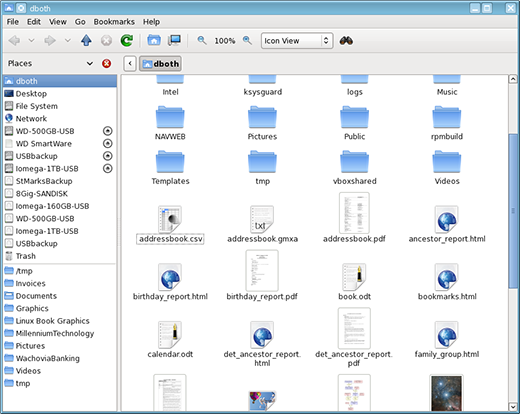probably the most standard administrative tasks that conclusion clients and administrators alike need to operate is file administration. Managing info can consume an enormous portion of your time. locating info, selecting which info and folders (directories) are taking probably the most disk area, deleting info, moving files, and simply opening info for use in an software are one of the crucial most basic—yet general—initiatives we do as computing device users. File management programs are equipment that are meant to streamline and simplify those vital chores.
Many decisionsMany people don't seem to be aware of the wide array of choices available in file managers, nor do they understand the full capabilities of those they do learn about. As with every aspect of Linux, there are many options obtainable for file managers. probably the most normal ones supplied by way of my favourite distribution, Fedora, are:
I even have used each of those at a considerable number of times for a variety of causes and they all have traits to suggest them. ranging from very standard to function-packed, there is a file manager obtainable with a view to meet your wants. middle of the night Commander and Krusader are my favourite file managers, and i use each somewhat commonly, however I also find myself the usage of Dolphin and Konqueror.
this article appears briefly at each and every of the file managers listed above and compares a number of of their main features. sadly, there isn't enough house to do each of those file managers justice. i hope to have some future articles that give a more special examine two or three of these potent tools.
each and every of those file managers is configurable, with Krusader and Konqueror being probably the most configurable of the GUI-based file managers. midnight commander, the lone text-primarily based file supervisor, is also reasonably configurable.
not one of the file managers seem to be via default like they do during this doc. I actually have configured them to seem like this on my programs. aside from dead night Commander, the shades are managed within the "software appearance" portion of the KDE equipment Settings software and are not configurable in the purposes themselves.
Default File managerLike most Linux distributions, Fedora has a default file manager, which is currently Dolphin. The Linux computer constantly has an icon that feels like a bit condo—that is your home directory/folder. click on on the home icon and the default file supervisor opens along with your home directory as the PWD, or current Working directory. In existing releases that use KDE 4.1 or above, the home icon is observed within the computing device Folder together with the Trash icon, as shown below.

In KDE, the default file supervisor may also be modified the usage of device Settings > Default purposes > File manager.
midnight Commandernighttime Commander is a textual content-based Command Line Interface (CLI) software. it's above all constructive when a GUI isn't available, but can also be used as a major file manager in a terminal session even for those who are the use of a GUI. i exploit midnight Commander commonly as a result of I commonly need to engage with local and far flung Linux computers using the CLI. It will also be used with essentially any of the common shells and remote terminals through SSH.

you could beginning dead night Commander from the CLI with the mc command. The above image suggests midnight Commander in one tab of the Konsole program. The user interface for hour of darkness Commander is two textual content mode panes, left and right, which every screen the contents of a listing. The appropriate of each pane displays the identify of the current directory for that pane. Navigation is achieved with the arrow and tab keys. The Enter key will also be used to enter a highlighted listing.
alongside the very top of the middle of the night Commander interface is a menu bar containing menu objects for configuring midnight Commander, the left and appropriate panes, and for issuing numerous file commands. The bottom element of the interface shows guidance about the file or directory highlighted in each pane, a touch function and a line of function key labels; which you can conveniently press the characteristic key for your keyboard that corresponds to the function you are looking to perform. Between the trace line and the characteristic keys is a command line.
KrusaderKrusader is an exceptional file manager this is modeled after hour of darkness Commander. It makes use of a similar two-pane interface, however's graphical in its place of textual content-based. Krusader offers many points that increase its functionality as a file supervisor. Krusader lets you use the equal keyboard navigation and command constitution as midnight Commander, and additionally permits you to use the mouse or trackball to navigate and operate all of the normal drag and drop operations you would are expecting on information.

The basic person interface for Krusader, a good deal like that of hour of darkness Commander, is 2 text-mode panes—left and right—which each reveal the contents of a listing. The precise of every pane contains the name of the existing directory for that pane. furthermore, tabs can be opened for each pane and a different directory will also be open in each and every tab. Navigation is achieved with the arrow and tab keys or the mouse. The Enter key may also be used to enter a highlighted directory.
each and every tab and pane can be configured to display files in one of two distinctive Modes. within the illustration above, files are displayed in the distinct view that—in addition to the file identify and an icon or preview—shows the file measurement, the date it changed into final modified, the owner, and the file permissions.
along the very proper of the Krusader GUI are a menu bar and toolbar containing menu objects for configuring Krusader and managing information. The backside portion of the interface shows a line of feature key labels; which you can quite simply press the function key to your keyboard that corresponds to the feature you need to perform. at the backside of the interface is a command line.
Krusader immediately saves the present tab and directory locations as well as different configuration gadgets so that you're going to all the time return to the last configuration and set of directories when restarting the software.
KonquerorKonqueror is one more effective and versatile file supervisor with many aspects. It has one function that not one of the other file managers do: it doubles as a web browser. just classification the URL of the internet site you need to view within the vicinity bar.
The leading component that sets Konqeuror aside from the gang is the skill to open numerous tabs, each of which could have one or more listing navigation panes. within the photograph beneath, one tab has been divided into three panes; one on the left aspect and two on the right. The sidebar at the a long way left is used to deliver rapid navigation of the total filesystem.

One element I specifically like about Konqueror is that it gives a brilliant excessive-stage view of your directory structure, each in the sidebar and in the directory panels. This makes it less difficult to find and delete information and listing timber that are no longer vital. It additionally permits less complicated navigation and reorganization of the listing structure.
The simple consumer interface for Konqueror, a lot like that of midnight Commander and Krusader, is text-mode panes that reveal the contents of a listing. Konqueror, youngsters, allows diverse panes, and the default single pane will also be break up both horizontally and vertically as repeatedly because it makes feel to accomplish that. Konqueror also supports diverse tabs (on the desirable of the listing panes this time) and a different set of directories will also be open in each tab. Navigation is completed with the arrow and tab keys or the mouse. The Enter key can be used to enter a highlighted listing. The place widget near the precise of the Konqueror GUI carries the entire path of the currently chosen pane.
each tab and pane will also be configured to reveal data in a single of two diverse Modes. within the above photo, info are displayed in the specified view which, apart from the file identify and an icon or preview, suggests the file measurement, the date it was last modified, the proprietor, and the file permissions.
along the very proper of the Graphical user Interface are a menu bar and tool bar containing menu items for configuring Konqueror and managing files. once you have the tabs and panes install the style you need them, you can reserve it so that Konqueror will all the time delivery with that configuration.
DolphinDolphin is very tons like Konqueror and Krusader. It has two directory navigation panes and a sidebar that permits for effortless filesystem navigation. It supports tabs.

The primary consumer interface for Dolphin can be configured to be very similar to Konqueror and Krusader. the use of two panes which each and every display the contents of a listing, it doesn't aid splitting the panes. Navigation is achieved with the arrow and tab keys or the mouse. The Enter key will also be used to enter a highlighted directory. Dolphin also supports expanding the listing bushes (folders) in both the sidebar navigation pane and the listing panes.
however Dolphin does aid tabs, when restarted it always reverts to the default of one pair of directory panes that screen your home directory.
NautilusNautilus has a single listing pane with which to work. It additionally has a sidebar for navigation. Nautilus is an easy, first rate file manager that is respectable for many newbies because of its simplicity. Nautilus is usually found in systems the place GNOME is the laptop, nonetheless it can also be installed and used with KDE.

The fundamental user interface for Nautilus is pretty fundamental with a navigation sidebar and a single directory window during which to work. It does not aid diverse tabs or splitting the panes. Navigation is accomplished with the arrow and tab keys or the mouse. The Enter key can also be used to enter a highlighted listing.
ThunarThunar is another light-weight file manager. it's so a great deal like Nautilus in the manner it appears and works and that there is nothing else to say about it.
PCmanFMThe PCManFM file manager is meant to exchange Nautilus and Thunar. definitely, in accordance with the way they appear and work so much alike, they might also actually share some standard code. These three file managers have the fewest configuration alternate options and all share the identical elementary interface.
XFEXFE is likely one of the more pleasing of the file managers as it has an interface all its own and is somewhat extra flexible than Nautilus, Thunar, and PCManFM.

XFE can be configured to display one or two directory panes, and the navigation bar is not obligatory. It performs the entire expected drag and drop functions, but it surely requires some guide configuration to affiliate the appropriate functions like LibreOffice with specific file forms. It has an affordable set of configuration alternate options, however nowhere close those of Konqueror or Krusader.
XFE is also rather intricate about maintaining its own set of "issues" and has no alternative to use the desktop color scheme, icons, decorations, or widgets.
conceptsi do know that there are other file managers, certainly one of which may well be your favorite. Your option of file supervisor should still be the one which works foremost for you. GNU/Linux offers a few achievable selections and one will without doubt meet most of your wants. in case your favourite does not meet your needs for a specific project, that you would be able to all the time use the one that does.
All of those file managers are free of can charge and allotted under some form of open supply license. All are available from normal, trusted repositories for Fedora and CentOS.
I plan to jot down some additional articles that cover some of those file managers in somewhat extra detail. Please go away your comments to let me understand which of them you may want to recognize extra about.
No comments:
Post a Comment